The Essential Role of the Association of Medical Coding in Healthcare
Medical coding is a cornerstone in modern healthcare. It ensures accurate documentation, efficient billing, and effective patient care. The healthcare industry will continue to evolve as we move into 2025. Medical coding associations play a key role in supporting professionals by providing education, credentials, and technological advances.
This blog will explore the role of medical coders, the importance of obtaining a medical coding certificate, and emerging trends that are shaping the future of the industry.
Why are Medical Coding Associations Important?
Medical coding associations (MCAs) are professional organizations which set standards, offer certifications, and provide ongoing education, often providing resources like the Financial Aid Guide for Medical Coding to ensure accuracy and integrity of medical billing and documentation.
These associations act as a link between healthcare providers and insurance companies and government agencies to ensure that healthcare services are coded and billed accurately. It is important to code accurately not only for reimbursement, but also in order to track health trends, conduct research and improve patient care.

The Key Functions of Medical Coding Associations
Certification and Credentialing. Associations such as AAPC and AHIMA offer certifications, including CPC (Certified Professional Coder), and CCS (Certified Coding Specialist), to validate the expertise and knowledge of professionals.
Education and Training: Workshops, webinars and certification programs are all ways to keep coders up-to-date with the latest standards, such as ICD-11.
Associations are involved in advocacy and regulation. They advocate for policies to support medical coders, and the healthcare system as a whole.
Building a community and networking: Online forums, online mentorship programs and conferences create a feeling of community for coders around the world.
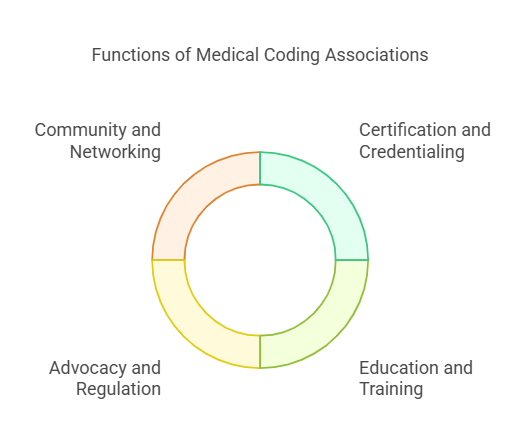
Medical Coding Associations and Healthcare
The impact of medical coding associations on healthcare efficiency and effectiveness is significant. They have a variety of impacts, including:
Revenue Cycle Management (RCM). Accurate coding reduces denials and ensures payments are made on time.
Documentation is key to a better patient experience:
Workforce Development: Organizations provide coders the skills they need to adapt to changing healthcare technologies.
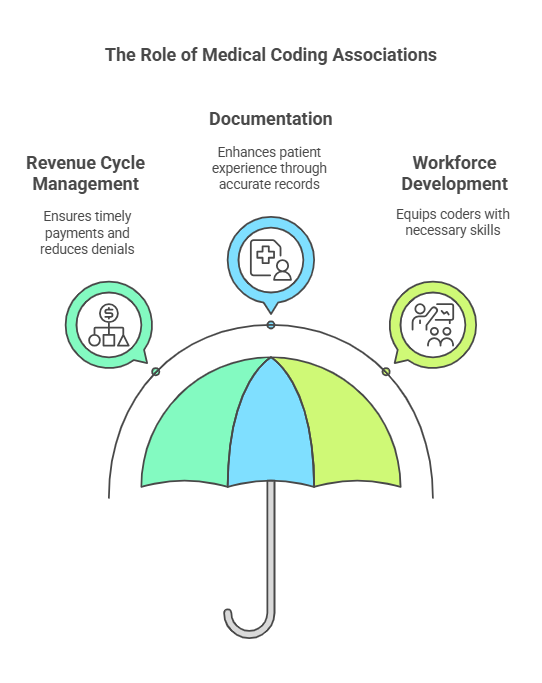
Leading Medical Coding Associations by 2025
There are many associations that offer resources and certifications in medical coding. Here are some of the most prominent organizations by 2025.
1. American Academy of Professional Coders
More than 300,000 members worldwide
Certifications include CPC, CPMA and CRC.
The focus is on practical training including telehealth coding.
2. American Health Information Management Association
Specializes in health information management.
Credentials like RHIA or RHIT are acceptable.
Data analytics is a key component of healthcare.
3. Medical Association of Billers
Medical billing practices are the focus of this article.
Certification programs such as CMBS and CMRS are available.
The updated courses reflect the changes in insurance policies.
4. American Medical Billing Association
Certifications support billing professionals.
Resources include coding software updates and training.
5. Healthcare Financial Management Association (HFMA)
The focus is on the financial aspect of healthcare.
This book provides insights into the value-based healthcare models.
Joining associations provides access to resources and professional development as well as networking opportunities in the industry.
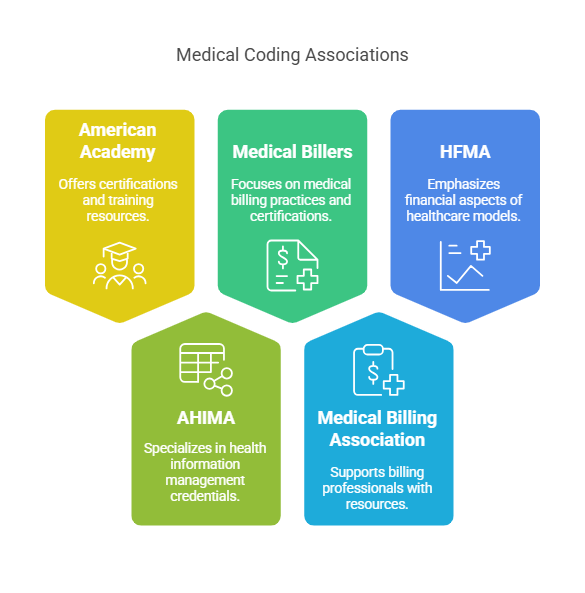
Medical Coders: The Demand is Growing in 2025
The demand for medical coders will increase as healthcare systems expand, and data-driven medicine becomes more common. The U.S. Bureau of Labor Statistics projects that employment of medical records specialist will grow by 9% between 2033 and 2033. This is a much faster rate than other professions.
Key factors driving demand
Aging Population: An older population increases healthcare utilization.
Telemedicine growth: Telehealth services need specialized coding expertise.
EHR Expansion - Adoption of electronic health records (EHRs) requires accurate coding.
Changes in Regulation: Updates to standards such as ICD-11 codes and CPT codes.
Medical Coding and Advanced Technology
Medical coding is being transformed by technology. It streamlines processes and reduces manual errors. By 2025, a number of technological advances will shape the field.
1. Artificial Intelligence and Machine Learning
AI-powered software for coding reduces errors, and accelerates claim processing.
The algorithms use historical data to analyze and predict billing issues.
2. Computer-Assisted Coding Systems
CAC systems help coders by suggesting possible codes based on the documentation.
The systems are more accurate, but they still need human supervision.
3. Blockchain Medical Records
Blockchain technology improves patient records' security and integrity.
Data consistency is ensured across all healthcare providers.
4. Telemedicine Coding Tools
Telehealth services necessitate specialized coding practices.
Now, associations offer training in telemedicine coding.
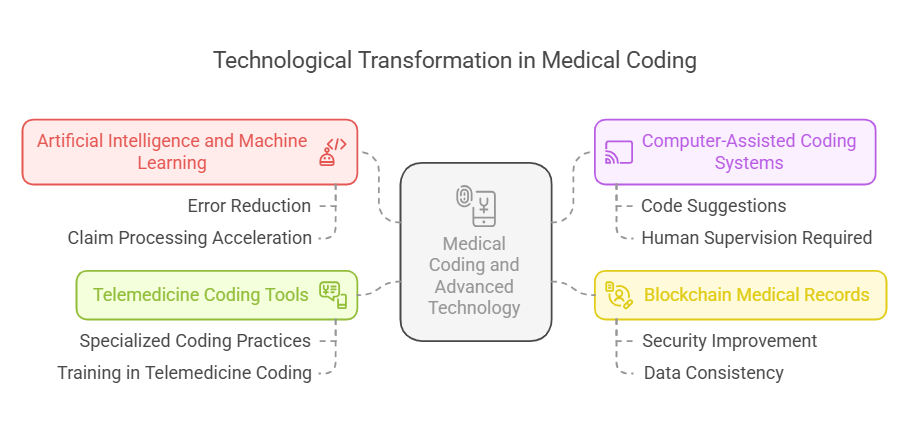
The critical role of medical coders in healthcare operations
Medical coders are unsung heroes in the healthcare system. They play a role that goes beyond data entry. They ensure accurate patient care, billing and research.
The Key Responsibilities for Medical Coders
Assigning Standardized Coding: Use CPT, ICD-10/ICD-11 and HCPCS to document diagnoses and procedures.
Compliance: Adherence to regulations, such as HIPAA guidelines and CMS guidelines.
Collaboration with Healthcare Teams: Work with billing specialists, physicians, nurses and other healthcare professionals to resolve discrepancies.
Contribute to the development of health statistics used in policy making.
Insight: Coders with data analytics and telehealth skills will be in high demand in 2025.
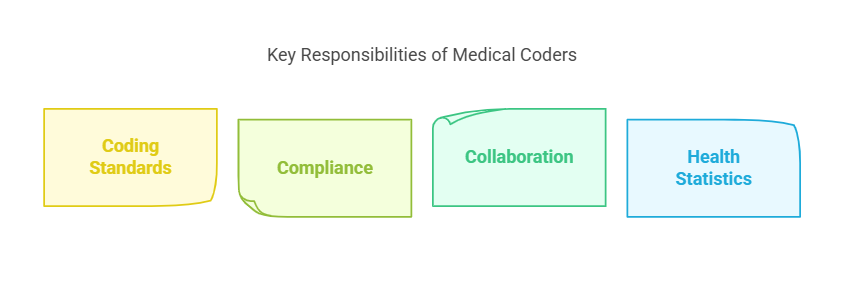
Medical Billing and reimbursement: the backbone of healthcare revenue
Medical billing and medical coding are intrinsically linked, as they ensure that healthcare providers get the appropriate reimbursement for their services.
The Medical Billing Process Steps:
Patient Registration: Collecting demographic information and insurance details.
Medical Coding: Transcribing patient records to standardized codes.
Claim submission: The process of submitting claims to insurers for payment.
Insurance companies adjudicate claims to determine whether they will pay or not.
Payment Posting: Entering payments received and dealing with denials, if needed.

Medical Coding Associations and Billing
Medical coding associations offer training to billing professionals on payer requirements, regulations, and billing software. AAPC, AMBA and other associations offer certifications for medical billing. These professionals are equipped with the necessary skills to navigate complicated billing processes.
Joining a Medical Coding Association Has Many Benefits
A professional association membership offers many benefits, including:
Certification is a sign of professionalism: Members with certification often have higher employment rates.
Continued Education: Courses, webinars and conferences keep skills up-to-date.
Online communities and conferences facilitate peer networking.
Job Market Insights : Members receive exclusive job listings, career resources and other benefits.
Updates on Regulation: Associations keep you informed of changes, such as the adoption of ICD-11.
Real-World Example In 2024, AAPC introduced telehealth coding certificates to address the surge of remote healthcare services. This trend is expected to continue into 2025.

Career Development and Growth for Medical Coders
Medical coding offers a variety of career options. Coders have many career options.
Medical Coding auditor: ensures accuracy of coding for reimbursement and compliance.
Revenue Cycle Manager: Manages all financial operations related to billing and coding.
Healthcare Data analyst: Uses data coding to identify trends and improve the delivery of care.
Medical Coding educator: Develops curriculum and trains new coders.

How associations support career growth
Associations offer resources like mentorship programs, certification courses, and career coaching tailored to emerging trends such as telehealth coding or AI integration.
Medical Coding Industry Trends for 2025 and Beyond
Medical coders need to adapt to the changing healthcare industry. The following are some of the key trends to keep an eye on:
1. ICD-11: Transition to ICD-11
The U.S. gradually moves from ICD-10 (the previous coding system) to ICD-11. This introduces new coding systems that reflect modern medical practices.
2. Privacy is a priority
Associations are focusing on training data privacy and compliance regulations such as HIPAA to combat the increasing cyber threat.
3. The demand for specialized coding is increasing
The complexity of healthcare requires coders who have specialized knowledge, such as in oncology and cardiology.
4. Telemedicine has a permanent place
Telehealth is not a temporary solution. It's now a part of the healthcare system, and it drives a need for specialized knowledge in telemedicine coding.

The role of medical coding in improving patient care
Medical coding is primarily used to support billing and revenue management. However, it plays an important role in patient care. Accurate coding assures:
Codes are a standard language that healthcare professionals can use to create consistent patient records.
Coding data can help identify patterns to guide treatment decisions.
Public Health Insights : Aggregated coding supports disease tracking and policy development.
How to choose the right medical coding association in 2025
The right association you choose can have a significant impact on your career. When choosing an association, consider the following:
Look for associations that have industry recognition such as AAPC or AHIMA.
Certification Options: Make sure they offer certifications that are relevant to your career objectives.
Education Resources: Look for online and accessible learning materials.
Choose associations that offer webinars, conferences and mentoring programs.
Review the benefits of membership: Resources, job listings and support are available to members.
Conclusion: Medical Coding's Future is Bright
Medical coding associations will continue to play a vital role as healthcare becomes increasingly data-driven and technology-advanced. These organizations will continue to equip professionals with the skills and knowledge they need to excel in an industry that is constantly evolving.
Joining a reputable organization can provide you with endless opportunities, whether you are a medical coder who is seasoned or considering a career. Stay informed, remain certified and join the healthcare movement that is driving excellence in the future.
Are you prepared to advance your career in medical coding? Join leading healthcare associations like AMBCI to stay at the forefront of innovation.
